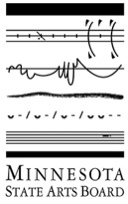920 E. Lake Street
Minneapolis, MN 55455
United States

Additional Details
Join us in welcoming Mexico in Minneapolis visiting artists David Sánchez Beltrán and Lucero Paniagua Ortuño.
Artist talk begins at 6 p.m.
The public is invited to meet David Sánchez Beltrán and Lucero Paniagua Ortuño at a free, welcome reception. This event will feature an on-stage conversation between the artists and Weisman Art Museum director Alejandra Peña Gutiérrez. Also in attendance will be the four selected Minnesota-Latinx artists for the Mexico in Minneapolis Folks Arts Residency: Cándida González, Claudia Valentino, Ivonne Yáñez, and Monica Vega.
All events will follow Minnesota Department of Health COVID-19 safety protocols.
About the Mexico in Minneapolis Folk Arts Residency
The Office of Arts, Culture & the Creative Economy and the Weisman Art Museum will host two artists from Cuernavaca, Morelos, México; David Sánchez Beltran and Lucero Paniagua Ortuño, in an artist residency May 29–June 7. The goal of the residency is to promote learning through cultural exchange and to revive, strengthen, and elevate the presence of and access to Mexican traditional art forms in Minneapolis.
In line with the City’s goals to address racial disparities, the effort invests in mentoring local Latinx artists and reconnecting Mexican immigrants to their traditional and cultural knowledge. David Sánchez Beltran will be paired with Cándida González and Claudia Valentino to exchange his expertise and skills as a painter, muralist, and ceramicist. Lucero Paniagua Ortuño will be paired with Ivonne Yáñez and Monica Vega, to exchange her expertise and skills on the extraction of pigments, dyes, and traditional techniques of the pre-Hispanic, colonial era. The apprentices are all Minnesota-based Latinx artists.
Through these apprenticeships, the Mexico in Minneapolis Folk Arts Residency seeks to connect members of the Mexican American diaspora to a richer sense of their cultural skills and identity as practiced through folk art traditions.
Learn more about the Mexico in Minneapolis Folk Arts Residency >>
Funding for this activity is provided by the Minnesota State Arts Board, the Graves Foundation and the City of Minneapolis.
David Sánchez Beltrán
David Sánchez Beltrán was born in Cuernavaca, Morelos, Mexico. He earned his Bachelor of Visual Arts degree from the Centro Morelense de las Artes (CMA; Morelos Center for the Arts) in 2013.
In 2016 David began his collaboration with the Centro Cultural Infantil La Vecindad, a children's cultural center founded in 1995 with a mission to introduce children to the visual arts, music, dance, and theater in a neighborhood of Cuernavaca, the capital of Morelos. Beltrán proposed a workshop on how to make jaguar masks from recycled materials. The popularity of this workshop grew into a cultural project extending its reach to migrant child laborers working with their families harvesting sugar cane in the municipality of Xochitepec, Morelos. In 2017, the workshop was extended to the city of Miacatlán, Moreles, for the children and adolescents from the nearby lake and town of the same name, Laguna del Rodeo.
In 2019, Beltrán became the Coordinator of La Vecindad. He began to teach drawing and painting classes to young girls, boys and teens living in state shelters within the Sistema Nacional para el Desarrollo Integral de la Familia (DIF; National System for the Comprehensive Development of the Family). Concurrently he produced a line of low and high-temperature ceramic objects called Abbure Tecuani (Brother Jaguar) in collaboration with his siblings, María Isabel, and Luis Fernando. Ceramics, along with graphic and pictorial techniques allow Beltrán other routes of representation.
Beltrán explores the relationships between the past and the present, notably through traditions such as the Danza de los Tecuanes – the dance of the jaguars, which coexists with characteristics of contemporary society. This intersectionality is what captures Beltrán’s imagination, the quality of memory which can be altered but not erased. His constant search for identity, the meaning of belonging, and reviewing his own familial history is a way of connecting with his origins, his family, and the land.
Lucero Paniagua Ortuño
Lucero Paniagua Ortuño was born in Cuernavaca, Morelos, Mexico. She received her Bachelor of Visual Arts degree from El Centro Morelense de las Artes (CMA; Morelos Center for the Arts) in 2017. Ortuño’s work delves deep into the extraction of pigments, dyes and the traditional techniques of the pre-Hispanic colonial era and the ways in which they are used by master craftsmen. Her research has focused primarily on practices within the states of Michoacán, Oaxaca, and Morelos. She explores colors, fibers and supports, working in a pictorial way and taking up implicit historical symbolisms in each pigment. Ortuño creates pigments and dyes extracted from; achiote (achiote); azafrán (saffron); cempaxúchitl(marigold); grana cochinilla (cochineal); curcuma (turmeric); muicle (honeysuckle); jamaica (hibiscus); palo de brasil(brazilwood), along with vegetable and mineral binders.
While a senior at CMA, she initiated research on organic pigments informed by Mexican traditions and exhibited her series “Orgánico” (Organic) at the Museo de la Ciudad de Cuernavaca (MuCIC; Cuernavaca City Museum). That same year she participated in the 10th Biennial of the Pacific with her series entitled, “Origen” (Origin) exhibited in Chilpancingo, Acapulco and Taxco de Alarcón, all in the state of Guerrero, Mexico. Her 2019 solo exhibition, entitled “Transmutaciones” (Transmutations) brought together research, exploration and pictorial executions incorporating dye and pigment extractions from cochineal; palo de brasil; achiote; turmeric; beet; and Mexican honeysuckle on paper, wood, and textiles.
In 2018, Ortuño held a workshop for children in Zitácuaro, Michoacán, on how to use knowledge through painting and collective memory based on cave paintings discovered near her home. In 2019 she conducted a workshop at La Casona Spencer Museum in Cuernavaca, on pigments and dyes in the plastic arts and the pre-Hispanic and colonial knowledge on extractions and how they may be applied in the arts.










